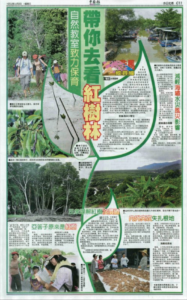Mock Tour of the UNEP-EPLC Project “Nature Classroom – Forest, Water and Us”
Date: 31st October 2011, Time: 7.30am – 3.30pm,
Venue: Balik Pulau, Penang Island
Number of participant: 22 (including two organizing members/volunteers)
In the early morning at about 7.30am, the participants were arriving at Kampung Ku Art Gallery and Guesthouse for registration. There were altogether 20 participants registered for this mock tour, which was more than the expectation. All participants were requested to sign indemnity form before departure.
Flow of activity:
(1) In the early morning at about 7.30am, the participants were arriving at Kampung Ku Art Gallery and Guesthouse for registration. There were altogether 20 participants registered for this mock tour, which was more than the expectation. All participants were requested to sign indemnity form before departure.
(2) Briefing was given by Miss Wong Yun Yun, the organizing member from WWP. She explained the project “Nature Classroom – Forest, Water and Us” and introduced WWP to the participants. Nevertheless, safety during the trip was reminded before the briefing ended.
(3) The first visiting place was the coastal mangrove site of Pulau Betong, Balik Pulau. The first-visit participants were trying to adapt the natural environment, especially the hot sun and mosquito bite! But the good thing was they all geared up nicely with long sleeves, long pants, caps, umbrellas and insect repellents.

(4) The participants were brought to observe the unique coastal plants and animals. Both adults and kids showed much curiosity in learning about them.
(5) Other than the biodiversity observation, the participants were being exposed to the ecological aspect of mangrove vegetation. For instance, the seed dispersal and early establishment of Bakau Minyak or Rhizophora apiculata, a mangrove species famous for making charcoal.
(6) One of the adventurous activities – crossing “nail carpet”. The hundred of nails was actually the aerial roots of Avicennia trees. The participant was carefully walking through them to avoid any destructive damage to the trees.
(7) After leaving the mangrove site, it was a short guided walk at Pulau Betong fishing village. The participants witnessed the coexistence of humans and nature as well as the mangroves that acted as natural shield against coastal hazards like the Indian Ocean tsunami in year 2004.
(8) The group headed to belacan factory at noon 12pm when the workers were drying shrimp paste under the sun. The factory owner was very friendly and he generously shared the belacan making process. From the visit, the participants learned how important the healthy waters and mangrove forests in providing fishery resources to people as food and daily income.
(9) Kuala Sungai Burong was the last visiting place. The beautiful scenery of natural and artificial regenerations of mangrove trees had captured everyone’s attention. The group was posing in front of the Rhizophora mucronata trees, which planted in year 2008.
(10) After having a good lunch time, all participants went back to Kampung Ku Art Gallery and Guesthouse to have idea sharing session. Some participants provided valueble comments and opinions that help improving the coming educational trips at Balik pulau. Survey forms were also given out to the participants for subsequent evaluation and analysis.
(11) Meanwhile, the kids were producing their artwork. They were indeed observant as they could draw very detail about the flora and fauna that they have seen during the mangrove adventure. They seemed to be very impressed by crabs and mangrove roots.
(12) At about 3.30pm, the happy journey was ended by taking a group photo. Conclusion: The mock tour was conducted as the preparation for implementing the UNEP-EPLC project “Nature Classroom – Forest, Water and Us” from December 2011 to August 2012. It ran smoothly and successfully with the positive participation of parent and kids, students, artists, young professionals and reporter. Personally, it was an invaluable and unforgettable experience since it was the inaugural trip and involving different people with age of 4 to 75. This is considered a good start and all the feedback from the participants will be regarded as important input to the project.
Prepared by: Wong Yun Yun, 1st November 2011


